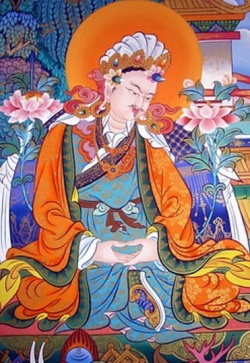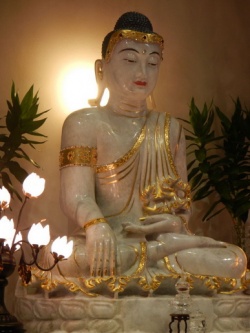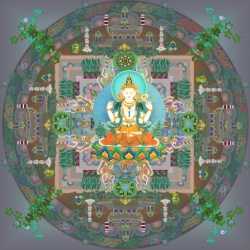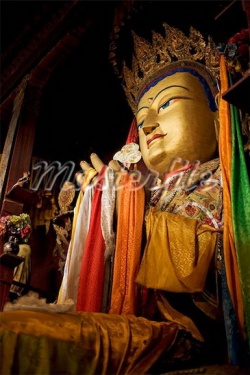Buddhism and Empire III: the Dharma King
Among the most celebrated figures in Tibetan history are the “dharma kings” (chögyal in Tibetan) who supported Buddhism and helped it to take root in Tibet. And probably the most important of all the dharma kings is Tri Song Detsen. Prince Song Detsen was given the title Tri – meaning “throne” – when he came of age, and he wasted little time in curbing the anti-Buddhist movement that had taken root in recent years since the death of his father, the previous king.
Seeking Buddhist teachers, first from China, then from Nepal and India, he went about getting Tibet its first proper monastery. That monastery, Samyé, was built with the help of the Nepalese abbot Śāntarakṣīta and the tantric adept from modern Pakistan, Padmasambhava. The king also supervised the ordination of the first Tibetan monks, and a vast project for the translation of Buddhist scriptures into Tibetan.
That is the briefest of summaries of the traditional Tibetan view of Tri Song Detsen’s achievements. If we turn to the Dunhuang manuscripts, we find – for once – that they are much in agreement with that traditional view. Tri Song Detsen is celebrated in quite a few Dunhuang poems and prayers as a great Buddhist king. Most of these celebrations of the king have already been translated (see the References section below) but I recently came across one that seems to have been missed. And it’s really quite interesting indeed…
- * *
IOL Tib J 466 is a scroll with a long prayer of offerings to the buddhas, bodhisattvas, deities, dharma kings and patrons of Buddhism. First among the kings is, of course, Tri Song Detsen.
I make offering to the spiritual teachers of our own Tibet,
The great dharma kings, like the great king Tri Song Detsen,
He who has mastered the royal methods of fortune,
And rules the kingdom with the sword of the sky-gods,
The magically emanated lord Tri Song Detsen;
And to those teachers who have gone to nirvāṇa,
Including Dharmāśoka, Kaniṣkā, Śīla Atidāna and so on;
To all of these propagators of the teachings
I respectfully make the offering of homage.
I suspect that this prayer dates from not too long after the reign of Tri Song Detsen himself. Every aspect of the scroll – paper, ink, handwriting, and the arrangement of the text on the page – is similar to the sutras commissioned by the last Tibetan kings at the end of the Tibetan Empire in the 840s. So the scroll may have been written only a half-century after the end of Tri Song Detsen’s reign.
The prayer puts Tri Song Detsen right into the historical tradition of dharma kings. Dharmāśoka is of course the famous Aśoka, ruler of the great Mauryan Empire in the 3rd century BC, and patron of Buddhism. Some of the edicts that he had carved throughout his empire still survive, and confirm that he was, to some extent, a Buddhist king. He is said to have convened the third council of the Buddhist sangha to clear up some doctrinal issues. As for Kaniṣka, he was the ruler of the Kushan Empire, based in Gandhara in the 2nd century AD, and we have evidence from the coins made in his reign that he supported Buddhism (among other religions). He is also credited with organizing a Buddhist council for the compilation of a Sanskrit Buddhist canon.
Considering the importance of the councils that Aśoka and Kaniṣka are supposed to have convened, it’s not surprising that the debate between Indian and Chinese Buddhism organized by Tri Song Detsen is often considered to be another council – in the grand tradition of dharma kings.
Of the identity of the king called Śīla Atidāna I have no idea. The first part of his name means “moral conduct” and the second “supreme giving”. The extreme generosity of bodhisattvas in some Buddhist stories is sometimes called “supreme giving”. One of the most popular of these stories is that of Prince Vessantara, who gave away his wife and children to a cruel Brahman (perhaps we should translate atidāna as “extreme giving”). In the end of the story the family is reunited and Vessantara is crowned king. So it could be this king that is intended here. I welcome any alternative suggestions…
As well as associating Tri Song Detsen with this Indian tradition of dharma kings, the prayer highlights the divine and magical nature of Tibetan kingship. The king has “mastered the royal methods of fortune.” What I’ve translated here as “fortune” is the enigmatic word phywa. In later Tibet it refers to luck, fortune-telling and the like. During the time of Tibet’s imperial kings, it seems to have been the special possession of the kings, but it as a method rather than a personal quality.
In any case, there wasn’t much distinction between the kings and the gods. The prayer also says that Tri Song Detsen “rules the kingdom with the sword of the sky-gods.” What does this mean? The Tibetan kings were thought to be the descendents (literally!) of a race of gods who lived in the sky, and came down to earth to perform their kingly duty. Instead of dying, they ascended back to the sky – beamed up along a “sky-cord” made of light. Later generations, including Tri Song Detsen, were said to have lost the sky-cord connection. Nevertheless, they were still the children of the gods (lhasé). That sword is an interesting symbol of the king’s military power, something that is downplayed – if not totally ignored – by many later Buddhist historians. Did Tri Song Detsen really carry a sword said to be inherited from his divine ancestors?
So it seems to me that in this prayer Tri Song Detsen stands somewhere between the earlier vision of Tibetan kings as agents of the divine – with magical military power and special royal methods of prognostication – and ideal of the Buddhist king as a patron and practitioner of Buddhism above all else.
- * *
Tibetan text
/ IOL Tib J 466/3: 5r.9–12: bdag cag bod khams kyI dge ba’I bshes gnyen//rgyal po chen po khri srong lde brtsan lastsogs pa//chos kyI rgyal po chen po rnams la mchod pa//phyva’i rgyal thabs mnga’ brnyes shing//chab srId gnam gyI lde mtshon can//’phrul rje khrI srong lde brtsan dang//dar ma sho ka/ka ni skā/shI la a tI da ṇya lastsogs//ston pa mya ngan ‘das phyIn//bstan pa rgyas mdzad thams cad la//phyag ‘tshal bsnyen bkur mchod pa dbul/
References
1. Karmay, Samten. 1998. “King Dza / Tsa and Vajrayāna” in The Arrow and the Spindle: Studies in History, Myths, Rituals and Beliefs in Tibet. Kathmandu: Mandala Book Point.
2. Richardson, Hugh Edward. 1998. “The Dharma that fell from Heaven” in High Peaks, Pure Earth: Collected Writings on Tibetan History and Culture, Edited with an Introduction by Michael Aris. London: Serindia.
Images
1. Tri Song Detsen: detail of 20th c. painting, sourced from Wikipedia.
2. Coin of Kanishka, (c) The British Museum.
3. Sky-cord (OK, a tornado).



